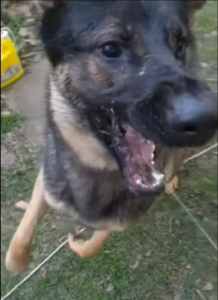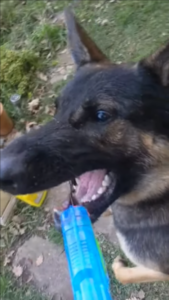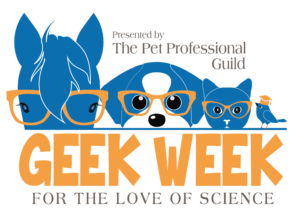Barks Blog
A Creative Solution for the Dog Who Barks at Other Dogs
By Kitty Lee
*This post is The Association of Pet Dog Trainers (APDT) Australia winning entry in our Geek Week 2020 Writers’ Competition*
Three years ago, I decided to become a professional dog trainer. I’d been teaching obedience classes at the local dog club and fostering rescue dogs since 2012 but I’d never had a dog of my own and I was pretty sure that was a requirement of being a dog trainer.
So I started looking for a puppy. I was very specific. I wanted a sable working line German shepherd. In my years of fostering German shepherds, most of them had come to me with all sorts of anxiety, aggression and health issues. So I was determined to find a well-bred, well socialized puppy from health and temperament tested parents.
I wanted this dog to be my business demo dog, I wanted to do ALL the dog sports, and I was also hoping he’d have the temperament to be my psychiatric assistance dog.
Perfect Puppy

For two years, I searched for my perfect puppy. Finally, in August 2019, I found a breeder with a litter that checked all my boxes. I brought home my dream puppy, Jazz, at 9 weeks old. He was perfect. He was environmentally confident, adjusted to things easily, settled when needed, and worked enthusiastically for both food and toys.
Everything was great. Except one thing.
The first time he saw another dog at 10 weeks old, he barked at him. Every time he saw a dog on the street, he barked at him. Puppy class was a nightmare. He spent entire lessons lunging and bouncing at the end of the leash, trying to go towards the other puppies and completely ignoring me, no matter what treats and toys I had.
Now, of course it’s normal for a young puppy to want to play with other puppies. But the intensity and persistence with which he fixated on other dogs at such a young age sent alarm bells ringing through my head.
What do a demo dog, a sports dog, and a service dog have in common? They all need to be able to focus on their human around other dogs. I needed to get on top of this, and fast.
Puppy Class
I signed him up to a second puppy class at my local dog obedience club. By the end of the course, he had made a little bit of improvement. He was able to acknowledge my existence and follow simple cues. I committed to bringing him every week to train around other dogs and show him I was more fun.
But circumstances conspired against us. Dog clubs here in Australia go on a two month break during December and January. This year, February and March were dominated by fires and the air was too thick with smoke for outdoor activities. This was followed by floods (welcome to Australia!).
I recall one weekend where nothing disastrous was happening, so I cleared my calendar, ready to finally get a chance to train only to find out class was canceled because the showgrounds had been hired out for a Tiny Homes Expo, of all things.
Impulse Control
In the meantime, I worked hard on impulse control behaviors, teaching Jazz to recall off a thrown toy and down while chasing the hose. This was the only activity he enjoyed almost as much as playing with other dogs. We did nose work, mat work and practiced default calm settles.
But still, every time we saw a dog on a walk, he would start pulling and lunging and barking. I simply couldn’t get enough distance on our narrow suburban streets to work with him.
Lunging and Barking at Other Dogs

I learnt to manage the behavior as best as I could. Attempts at emergency U-turns usually resulted in me dragging a writhing, barking crocodile backwards down the street. So when I saw a dog approaching, I would cross the road. As the other dog went past, I would drop treats between Jazz’s paws as fast as he could eat them.
He would eat each treat mechanically, eyes glued to the other dog, occasionally still managing a bark in between treats. Sometimes, he would refuse the treats, and I would just have to hold him by the collar until the other dog was gone, whining like an agility dog at the start line.
It was like he was in a trance. Nothing I said or did could break his stare.
He wasn’t anxious or fearful. His problem was quite the opposite. As another trainer said to me recently, “He has too much value for other dogs.”
If I had to put it in numbers, I would say that food is an 8/10, tug is an 8/10 and sniffing the butt of that dog across the street is a 12/10. As much as he liked the cubes of steak and sheepskin tugs I was waving in front of his face, I just couldn’t win against that 12.
The only thing that came close was chasing the hose, but I could hardly bring a hose with me on a walk.
At Jazz’s breeder’s recommendation, we started going to dog parks and working outside the fence, where I could easily control distance. Jazz became great at ignoring dogs behind a visual barrier, but his behavior with dogs on walks didn’t change.
I was counting the days until dog club started again, and I would have the environment I needed to really tackle the problem. I don’t drive, and my ability to do setups was limited.
COVID
And then COVID struck, and classes were canceled indefinitely. It seemed like the universe was determined to screw me over. Lockdown laws and social distancing meant that the only time Jazz saw other dogs was on walks.
It also meant that everybody and their aunt was out walking their dogs, and suddenly it was impossible to walk down the street without running into five or six other dogs, no matter the time of day or night!
Also around this time, adolescence hit Jazz with a vengeance. Attentiveness went out the window along with his loose leash walking, and his behavior when he saw other dogs dramatically worsened.
Forget sports dog, or service dog. I just wanted a dog I could walk! I started desperately seeking information. I built his drive for tugs and toys. I purchased all of Leslie McDevitt’s Control Unleashed series and practiced LAT and all her pattern games.
I read books, watched webinars, signed up to courses. I consulted a veterinary behaviorist. All the resources just told me to keep doing the things I was already doing.
So I did. And over the next few months, things kind of stalled. Each walk was still meticulously planned, and I was still unable to break his focus when he saw another dog, but at the very least I was mostly able to stop the barking and lunging again.
Eureka Moment
And then, a few weeks ago, I was shopping for a birthday present for my 10-year-old nephew. I found myself in an aisle full of nerf guns, and right in front of me, a water gun. A light bulb went off in my head. I purchased the smallest one that would fit in my pocket, and went home to try it out.
From the moment I first squirted it in the direction of his face, Jazz was obsessed. It was everything he loved about chasing the hose, condensed in miniature.
The next day, I took him and the water gun out for a walk. Every time he saw another dog, I marked and started a fun game with the water gun. By the third dog, Jazz looked at the dog, and then immediately spun to me, waiting for the game to start.
In one walk, I had managed to achieve something I’d been working on for almost a year. I was so happy I could’ve cried.
Training Game
Of course, not everything was perfectly and immediately fixed. We still have to cross the road and let the other dog go past. Jazz still gets over-aroused, anticipating exciting things. And I discovered early on that the water gun leaks, leaving an extremely awkward wet patch on the front of my pants by the end of each walk.
But, in a few short weeks, I have a dog who went from being unable to look away from another dog, to enthusiastically volunteering his attention to me with a dog just on the other side of the street. He’s still very young, and we have time. For the first time in a long time, I feel optimistic about our future.
In the short 12 months that I’ve had my wonderful Jazz, he has taught me many lessons. From letting go of expectations and appreciating what’s in front of me, to really understanding the idea that reinforcement is decided by the individual learner – I bet most dogs you know would hate being squirted in the face with water!
But the most important thing I’ve learnt from this water gun episode is the value of creativity and learning how to think outside the box when things aren’t working. After all, who would’ve thought that the solution to all my problems was a five dollar, blue and green, plastic children’s toy?
Resource
Lee, K. (2020, September 27). Jazz vs Water Gun Slomo [Video File]
This post is The Association of Pet Dog Trainers (APDT) Australia winning entry in our Geek Week 2020 Writers’ Competition. All winning and other selected entries are being published here on the BARKS Blog and in upcoming issues of BARKS from the Guild.
For a fully immersive educational experience in all things animal behavior and training, join us for Geek Week, a virtual educational event taking place 24/7 with over 85 presenters and 135 educational sessions, on November 11-15, 2020. Session recordings will be available for ONE YEAR after the event!
About the Author
Kitty Lee is a dog trainer based in Sydney, Australia. She is fairly new to the industry, although dog training has been her hobby for a while. To date she has completed her Cert IV in companion animal services, Living and Learning with Animals by Dr. Susan Friedman, Aggression in Dogs master course with Michael Shikashio, and a range of courses with the Fenzi Dog Sports Academy.


